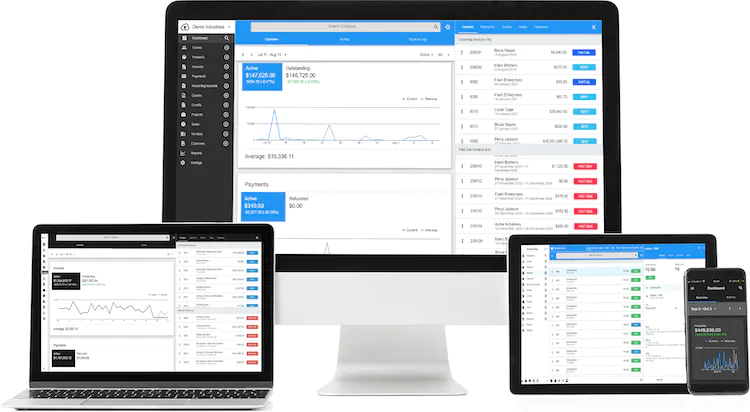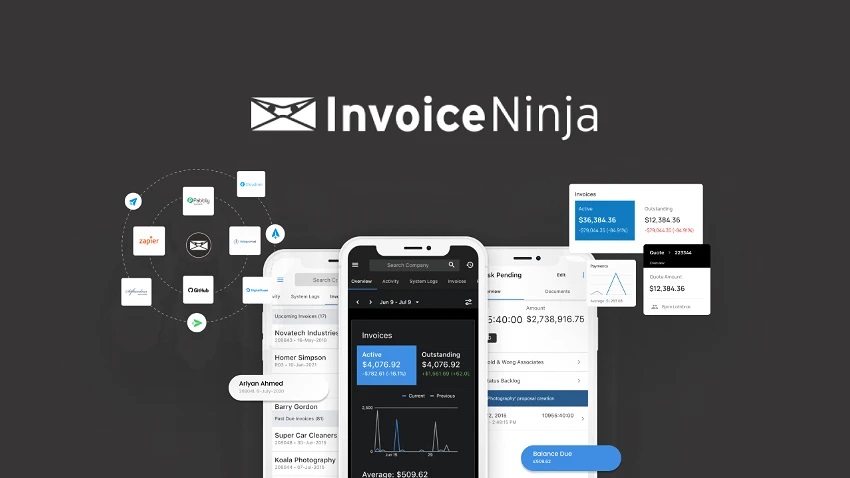Last updated on November 6th, 2023 at 05:07 am
If you’re looking for a way to run Invoice Ninja behind a reverse proxy, Nginx is a great option.
By using Nginx as a reverse proxy, you can improve the performance and security of your Invoice Ninja installation.
In this article, we’ll explore how to set up Invoice Ninja behind an Nginx reverse proxy and discuss the benefits of doing so.
But before that, what is Invoice Ninja?
Understanding Invoice Ninja
Invoice Ninja is a digital invoicing platform that helps businesses streamline their invoicing process.
It offers a complete suite of invoicing and payment tools designed to help freelancers and business owners get paid accurately and securely.
With Invoice Ninja, you can create custom invoice templates, track expenses, manage vendors, and sign invoices with a digital signature.
Let’s look at the key features of Invoice Ninja, the benefits of using it for businesses, and the importance of secure access.
Key Features of Invoice Ninja
Invoicing: With Invoice Ninja, you can create and send invoices in seconds, create recurring invoices, and send invoices and quotes via Gmail and MSN accounts.
Payments: Invoice Ninja also enables you to accept credit cards, ACH payments, PayPal, and more. Clients can pay directly from their invoice with the click of a button.
Time Tracking: In addition, you can send billable tasks to invoice with one click. The task time-tracking feature allows you to record every second spent on each individual task accurately.
Expense Tracking: Using Invoice Ninja, you can easily create and manage expenses, convert and invoice clients for expenses, create vendors and organize categories, and expense reporting.
Project Management: It can as well allow you to create projects, and tasks, and track time. You can also organize tasks under a project umbrella.
Customizable Invoice Templates: You can choose from a library of professional invoice templates or create your own when using Invoice Ninja.
Digital Signature: It enables you to sign invoices with a digital signature, eliminating the need for paper and reducing businesses’ carbon footprint.
Benefits of Using Invoice Ninja for Businesses
1. Streamlines invoicing process, enhancing efficiency.
2. Accurate time tracking and billing of hours worked.
3. Effective expense management.
4. Seamless project management.
5. Compatibility with a wide variety of payment gateways.
6. Simplifies billing process.
7. Improves project execution.
8. Boosts productivity and efficiency.
Importance of Secure Access
Secure access is crucial for businesses that use Invoice Ninja.
Invoice Ninja employs rigorous security measures, including:
1. Two-factor authentication.
2. Role-based access control.
3. An encrypted secure socket layer (SSL).
4. Data policy adherence to major global data protection regulations.
By using secure access, businesses can protect their sensitive data and prevent unauthorized access.
Now that we are well conversant with Invoice Ninja, let’s explore the Nginx Reverse Proxy.
What is Nginx Reverse Proxy?
Nginx is a popular open-source web server that can function as a reverse proxy.
A reverse proxy is an intermediary server that forwards client requests to the appropriate backend server and returns the server’s response to the client.
Let’s define Nginx’s role as a web server and reverse proxy, explain how reverse proxy works and its advantages, and mention common use cases for Nginx reverse proxy.
Nginx as a Web Server and Reverse Proxy
Nginx is a high-performance web server that can handle many concurrent connections.
It is designed to be lightweight, efficient, and scalable.
Nginx can also function as a reverse proxy, which means it can act as an intermediary between clients and backend servers.
How Reverse Proxy Works and Its Advantages
A reverse proxy accepts requests from clients and forwards them to the appropriate backend server.
The backend server processes the request and sends the response back to the reverse proxy.
The reverse proxy then returns the response to the client.
Advantages of using a reverse proxy include:
Load balancing: A reverse proxy can distribute client requests across multiple backend servers, improving performance and preventing server overload.
Security: A reverse proxy can protect backend servers from direct exposure to the internet, preventing attacks and improving security.
Scalability: A reverse proxy can help scale applications by allowing multiple backend servers to handle client requests.
Common Use Cases for Nginx Reverse Proxy
Load balancing: As mentioned, Nginx efficiently balances client requests among multiple backend servers, enhancing performance and averting server congestion.
Web acceleration: Nginx can cache frequently accessed content, reducing the load on backend servers and improving performance.
Security: As previously stated, Nginx enhances security by shielding backend servers from direct internet exposure.
SSL termination: Nginx can terminate SSL connections, reducing the load on backend servers and improving performance.
API Gateway: Nginx can act as an API gateway, routing requests to the appropriate backend server and providing authentication and rate limiting.
Setting Up Nginx for Invoice Ninja
Here’s a step-by-step guide on how to set up Nginx for Invoice Ninja:
Prerequisites
A server running Ubuntu 22.04 or later
Nginx web server installed
PHP 7.1 or 7.2 and MySQL installed
Installing Nginx
If Nginx is not already installed, follow these steps to install it:
Update the package list: ‘sudo apt update’
Install Nginx: ‘sudo apt install nginx’
Start Nginx: ‘sudo systemctl start nginx’
Enable Nginx to start on boot: ‘sudo systemctl enable nginx’
Configuring Server Blocks in Nginx for Hosting Invoice Ninja
Create a new server block configuration file: ‘sudo nano /etc/nginx/sites-available/invoiceninja’
Add the following configuration to the file:
server {
listen 80;
server_name your_domain.com;
root /var/www/invoiceninja/public;
index index.php;
location / {
try_files $uri $uri/ /index.php?$query_string;
}
location ~ \.php$ {
include snippets/fastcgi-php.conf;
fastcgi_pass unix:/run/php/php7.2-fpm.sock;
}
}
Save and close the file.
Create a symbolic link to enable the server block: ‘sudo ln -s /etc/nginx/sites-available/invoiceninja /etc/nginx/sites-enabled/’
Test the Nginx configuration: ‘sudo nginx -t’
Restart Nginx: ‘sudo systemctl restart nginx’
SL/TLS Configuration for Security
Securing Invoice Ninja with SSL/TLS is crucial for protecting sensitive information from unauthorized access.
Let’s delve into the importance of securing Invoice Ninja with SSL/TLS, explain how to obtain and install SSL certificates, and walk through the Nginx SSL configuration for Invoice Ninja.
Importance of Securing Invoice Ninja with SSL/TLS
SSL/TLS encryption protects sensitive information from unauthorized access.
It is essential for compliance with data protection regulations.
It also improves customer trust and confidence in your business.
Obtaining and Installing SSL Certificates
You can obtain a free SSL/TLS certificate from ‘Let’s Encrypt’, a non-profit certificate authority that provides free SSL/TLS certificates.
Alternatively, you can purchase an SSL/TLS certificate from a commercial certificate authority.
After obtaining an SSL/TLS certificate, you will need to configure Nginx to use it.
Nginx SSL Configuration for Invoice Ninja
To enable SSL/TLS on Nginx, you will need to modify the Nginx configuration file.
The Nginx configuration file is located in the /etc/nginx directory and is typically named nginx.conf.
Within the HTTP block, you should add the following lines to enable SSL/TLS:
server {
listen 443 ssl;
server_name your_domain.com;
ssl_certificate /path/to/your_domain.crt;
ssl_certificate_key /path/to/your_domain.key;
ssl_protocols TLSv1 TLSv1.1 TLSv1.2;
ssl_ciphers HIGH:!aNULL:!MD5;
}
Restart Nginx to apply the changes.
Load Balancing and Scalability
Nginx can be used for load balancing multiple Invoice Ninja instances.
Load balancing improves scalability and redundancy.
A sample configuration for load balancing can be:
upstream invoiceninja {
server 192.168.1.10:8000;
//IP addresses
server 192.168.1.11:8000;
server 192.168.1.12:8000;
}
server {
listen 80;
server_name your_domain.com;
location / {
proxy_pass http://invoiceninja;
proxy_set_header Host $host;
//setting headers
proxy_set_header X-Real-IP $remote_addr;
proxy_set_header X-Forwarded-For $proxy_add_x_forwarded_for;
}
}
First, we define an upstream block that lists the IP addresses and ports of the backend servers running Invoice Ninja.
We then define a server block that listens on port 80 and proxies requests to the backend servers using the ‘proxy_pass’ directive.
The ‘proxy_set_header’ directives are used to set the appropriate headers for the backend servers to correctly identify the client’s IP address and other information.
Optimizing Performance
To optimize Nginx and Invoice Ninja performance, you can use caching and compression techniques.
You can also set up Nginx for handling high-traffic loads.
Monitoring and Logging
Monitoring and logging are important for troubleshooting and security.
There are several tools and techniques for monitoring Nginx and Invoice Ninja.
Comprehensive logging can be set up by modifying the Nginx configuration file.
Common issues that may arise when setting up Invoice Ninja with Nginx include SSL/TLS configuration errors and server block configuration errors.
Solutions to potential challenges can be found in the DigitalOcean tutorial.
Conclusion
In conclusion, using Nginx as a reverse proxy for Invoice Ninja offers enhanced performance and security.
It streamlines the invoicing process, secures access, and optimizes operations.
With this setup, businesses can efficiently manage invoices and protect sensitive data, ultimately boosting productivity and trust.






